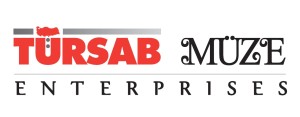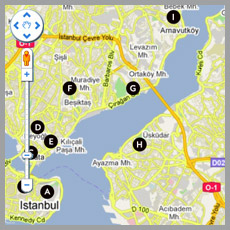By Aylin Şen
Turkey’s first and so far only Nobel-laureate novelist Orhan Pamuk accomplished yet another ‘first’ by establishing Turkey’s first ‘everyday life museum’: the “Museum of Innocence”. Although based on a single person’s imagination, the museum has something to offer for everyone.
A total number of 4213 butts of cigarettes each one having supposedly been smoked down to the filter by Füsun, the object of Kemal’s obsessive love in the author’s novel of the same name as the museum. And who is Kemal? Maybe Orhan Pamuk himself or a hidden part of him? In actuality, the author, the novel ‘Museum of Innocence’ and the physical Museum of Innocence which gives life to the book constitute integral parts of a whole. It is difficult to put exact boundaries between these three components. Pamuk started collecting the items currently displayed at the museum before he wrote the novel and continued collecting while writing “Museum of Innocence.” He collected for years, old postcards, old timers’ single records, bottles of PE RE JA brand eau de cologne, wristwatches, out of order clocks, melamine dishes, salt shakers, cinema tickets for black and white movies, Füsun’s yellow pumps and thousands of other objects reminiscent of the bygone world in which the book is set.
Walking through the displays, one realizes why Orhan Pamuk opted for the name “innocence” for his museum. Visitors will find there reminiscences of their own childhood or youth, their own ‘age of innocence’! According to Pamuk, the idea for his museum and his novel “evolved together.” While writing the book he collected more than a thousand artefacts which reflect the story, from a tricycle to dozens of ceramic dogs, from lottery tickets to news clippings. He wrote the novel by looking at those objects and forging fiction. At the same time, he kept making plans to set up his unprecedented museum. The Nobel Prize came as a welcome opportunity to implement his plans. He says having devoted the entire award money to finance the museum project.
First step towards the creation of the museum was the establishment of the “Innocence Foundation” in 2009, with a capital of one million Turkish Liras. Its purpose was formulated in following terms:
“The Foundation is instituted with a view to establishing and operating museums, named Museum of Innocence and/or otherwise, setting up culture and art centres propitious to the awakening of new, pristine, innocent aspects of the fields of art and thought, by unveiling the genuine and innocent character of creative art; supporting the undertakings of Ferit Orhan Pamuk in the area of culture, art, literature and communication; conducting studies on the subject matter; promoting and organizing various activities, meetings, events, exhibitions in the fields of culture, art, literature and communication; performing the operations, implementing the activities as stated under the chapter “Activities of the Foundation” (of this Statute).”
Curator of this unique museum located in a 19th-century house, remodelled for the purpose, on a quiet street in the Çukurcuma neighbourhood, is also Orhan Pamuk himself who meticulously created compositions out of these single objects in order to organize the museum’s displays according to the story line of the book; as he says having conceived the novel and the museum together.
MANIFESTO FOR MUSEUMS
The painstaking process of writing a novel and bringing a museum to fruition in parallel might have been enough work for anyone. Not so for Pamuk. The author has now written a
book about the museum, entitled “The Innocence of Objects” in which he describes the background story of the museum’s creation process and includes in it his “Modest Manifesto for Museums” as quoted below:
1 • Large national museums such as the Louvre and the Her-mitage took shape and turned into essential tourist destina-tions, alongside the opening of royal and imperial palaces to the public. These institutions, now national symbols, have presented the story of a nation –in other words, history- as much more important than the stories of individuals. This is unfortunate: the stories of individuals are much better suited to displaying the depths of our humanity.
2 • We can see that the transition from palaces to national museums, and from epics to novels, are parallel processes. Ep-ics are like palaces, and speak of the heroic deeds of old kings who lived in them. National museums, then, should be like novels; but they are not.
3 • We are sick and tired of museums that try to construct historical narratives of a society, community, team, nation,state, people, company or species. We all know that the ordinary, everyday stories of individuals are richer, more humane and much more joyful than the stories of colossal cultures.
4 • Demonstrating the wealth of Chinese, Indian, Mexican, Iranian or Turkish history and culture is not an issue it must, of course, be done, but it is not difficult to do. The real chal-lenge is to use museums to tell, with the same brilliance, depth and power, the stories of the individual human beings living in these countries.
5 • The measure of a museum’s success should not be its abil-ity to represent a state, nation or company, or a particularhistory. It should be its capacity to reveal the humanity of individuals.
6 • It is imperative that museums become smaller, more individualistic, and cheaper. This is the only way that they will ever tell stories on a human scale. Big museums with their wide doors call upon us to forget our humanity and embrace the state and its human masses. This is why millions outside the western world are afraid of visiting museums.
7 • The aim of present and future museums must not be to represent the state, but to recreate the world of single human beings – the same human beings who have laboured and suffered under cruel oppressions for hundreds of years.
8 • The resources that are channelled into monumental, symbolic museums should be diverted into smaller museums that tell the stories of individuals. These resources should also be used to encourage and support people in turning their own small homes and stories into exhibition spaces.
9 • If objects are not uprooted from their homes and their streets, but are situated with care and ingenuity in their own natural settings, they will spontaneously portray their own stories in an authentic manner.
10 • Monumental buildings that dominate neighbourhoods and entire cities do not bring out our humanity; on the con-trary, they quash it. It is more humane to be able to imagine
modest museums that turn the neighbourhoods and streets, and the homes and shops nearby, into elements of the exhibi-tion.
11 • The future of museums is inside our own homes. The picture is, in fact, simple:
Then: Epics, Representation, Monuments, Histories, Na-tion, Groups, Teams, Large and expensive. Now: Novels, Expression, Homes, Stories, Person, the Individual, Small and
inexpensive.
This article has originally appeared in “Müze” Magazine, published quarterly with the contributions of the Ministry of Culture and Tourism. We would like to thank TÜRSAB Museum Enterprises for sharing this piece with Istanbul Digital Platform followers.




















